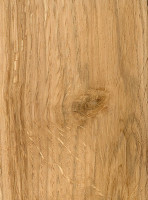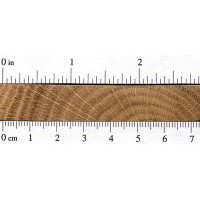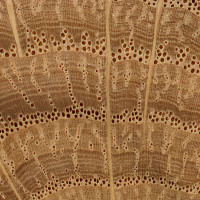 |
Common Name(s): Scarlet Oak
Scientific Name: Quercus coccinea Distribution: Eastern United States Tree Size: 65-100 ft (20-30 m) tall, 3-4 ft (1-1.2 m) trunk diameter Average Dried Weight: 46 lbs/ft3 (735 kg/m3) Specific Gravity (Basic, 12% MC): .60, .73 Janka Hardness: 1,400 lbf (6,230 N) Modulus of Rupture: 16,080 lbf/in2 (110.9 MPa) Elastic Modulus: 1,766,000 lbf/in2 (12.18 GPa) Crushing Strength: 8,250 lbf/in2 (56.9 MPa) Shrinkage:Radial: 4.4%, Tangential: 10.8%, Volumetric: 14.7%, T/R Ratio: 2.5 |
Color/Appearance: Has a light to medium reddish-brown color, though there can be a fair amount of variation in color. Conversely, White Oak tends to be slightly more olive-colored, but is by no means a reliable method of determining the type of oak.
Grain/Texture: Has medium-to-large pores and a fairly coarse grain.
Rot Resistance: Red oaks such as Scarlet Oak do not have the level of decay and rot resistance that White Oaks possess. Durability should be considered minimal.
Workability: Easy to glue, and takes stain and finishes very well.
Odor: Has a tell-tale smell that is common to most oaks. Most find it appealing.
Allergies/Toxicity: Although severe reactions are quite uncommon, oak has been reported as a sensitizer. Usually most common reactions simply include eye and skin irritation, as well as asthma-like symptoms. See the articles Wood Allergies and Toxicity and Wood Dust Safety for more information.
Pricing/Availability: Slightly less expensive than White Oak, Red Oak is in good/sustainable supply and is moderately priced. Thicker 8/4 planks, or quartersawn boards are slightly more expensive per board foot.
Sustainability: This wood species is not listed in the CITES Appendices or on the IUCN Red List of Threatened Species.
Common Uses: Cabinetry, furniture, interior trim, flooring, and veneer.
Comments: Scarlet Oak falls into the red oak group, and shares many of the same traits as Red Oak (Quercus rubra). Red Oak, along with its brother White Oak, are commonly used domestic lumber species. Hard, strong, and moderately priced, Red Oak presents an exceptional value to woodworkers—which explains why it is so widely used in cabinet and furniture making.
- Black Oak (Quercus velutina)
- Bog Oak
- Brown Oak
- Bur Oak (Quercus macrocarpa)
- California Black Oak (Quercus kelloggii)
- Cherrybark Oak (Quercus pagoda)
- Chestnut Oak (Quercus prinus)
- English Oak (Quercus robur)
- Holm Oak (Quercus ilex)
- Japanese Oak (Quercus mongolica)
- Laurel Oak (Quercus laurifolia)
- Live Oak (Quercus virginiana)
- Oregon White Oak (Quercus garryana)
- Overcup Oak (Quercus lyrata)
- Pin Oak (Quercus palustris)
- Post Oak (Quercus stellata)
- Red Oak (Quercus rubra)
- Sessile Oak (Quercus petraea)
- Shumard Oak (Quercus shumardii)
- Southern Red Oak (Quercus falcata)
- Swamp Chestnut Oak (Quercus michauxii)
- Swamp White Oak (Quercus bicolor)
- Turkey Oak (Quercus cerris)
- Water Oak (Quercus nigra)
- White Oak (Quercus alba)
- Willow Oak (Quercus phellos)








I bought engineered hardwood maple but when it was sanded it was reddish from pinkish to red brown The flooring professional told me it was red oak Is it possible to know from photos what it is? The flooring company claims it is maple It was manufactured by Brightwood Canada in Quebec
Yes, that certainly looks like maple to me. Definitely not red oak.
Thank you for the information Eric, what should I look for to confirm a wood is mapler and not red oak? I was expecting maple (hard maple, or sugar maple) to be much paler, beige not reddish, and with fewer knots and colour variations. Is this some other type of maple?
Oak and maple are quite different woods if you know what to look for. Oak is a ring porous wood that has very large earlywood pores that mark the beginning of the spring growing seasons. What this translates to is that the growth rings in oak boards will have an indented texture where the large pores form a ring. Maple is diffuse porous, so although visually it still has growth rings, they will be smooth and aren’t marked by any earlywood pores. Furthermore, oak has very wide and conspicuous rays that can be seen even on the face grain (appearing… Read more »